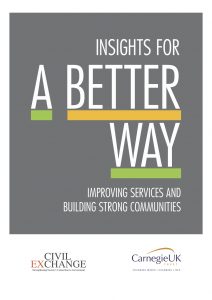‘Insights for a Better Way’ is a collection of almost 50 essays, edited by Caroline Slocock for Civil Exchange/Carnegie Trust and published in July 2018. Here is Tom’s contribution…

Once upon a time big companies did CSR (Corporate Social Responsibility). It subtly reminded employees that they were team members whilst ticking a few philanthropy boxes and was delivered by – well, that didn’t really matter. Maybe volunteers, perhaps a dedicated department with no other role in the company, rarely the HR people. And adopting a ‘Charity of the Year’ allowed the company’s goodness to be more widely appreciated; charities liked it because it was easier to get money from a new source each year than wring it out of an old one. For them, raising money was, mostly, what it was all about.
Things have changed.
First, some companies realised that their choice of charity partner was significant: the right choice signposted the purpose and mission of the business far more than did random fluffy animals, well-known diseases or distant children, causes that polls of employees were prone to promote. Second, they realised that a year was not long enough to build a proper relationship or learn from missed opportunities. And third, cash was not necessarily king: time and skills could be at least as much appreciated as money when appropriately deployed.
This meant that new ideas could take root:
- Flexibility, rather than the rigid ‘corporate volunteering day’, was more attractive both to charities and to participating employees.
- As sceptics pointed out, employee volunteers were not really volunteers: they were being paid whilst working alongside those ‘doing it for nothing’. It was the company, not the individuals, that was contributing its time and skills.
- Integrating CSR into the mainstream operation of the company, rather than treating it as an optional extra, could benefit the company.
This new generation of company citizens talked of ‘purpose’, ‘mission’ and ‘partnership’, leading to a less altruistic, possibly more honest approach: there was nothing wrong with the company profiting indirectly from its engagement with good causes. Indeed, this justifies any investment made in the process.
So, we’ve moved from employees taking initiatives to sponsor each other, bake cakes and ride bikes for money, through communal days out for painting or gardening, through providing the skills that charities and community groups need – right through to a company expressing its own mission and purpose through a strategic approach to its relationship with the community.
‘Health at Work’ is a multifaceted British Heart Foundation (BHF) campaign. Companies that engage with it gain from reduced sickness absence, higher morale, better team building and reduced early retirement on illness grounds. The return on investment for a workplace health strategy can be as much as 34:1 based on reducing absenteeism, accidents and staff turnover and the resulting improvement in productivity. Participating companies also report better employee engagement and internal communications. At Asda’s distribution centre in Leicestershire BHF promotes its Workplace Wellbeing Charter. Here, on-site gym membership costs employees £3 per month and the company supports free fruit days, helps employees buy bicycles, offers smoking cessation clinics and health checks and even stages a ‘coast-to-coast’ static cycle event to raise money for BHF. The Asda scheme initially reduced absenteeism by 1.5 per cent – worth £200,000 to the company, a massive return on a £20,000 investment, in a single year.
Four hundred employers and 10,000 individuals have backed the Time to Change pledge. Led by charities Mind and Rethink Mental Illness it’s a commitment to change attitudes and risks around mental health. The charities help create bespoke workplace plans including events to support mental health Champions. Longstanding supporters include Transport for London, Imperial College, E.ON, Anglian Water and Lloyds Bank. A manager in a big white-collar company noted that the main cause of death in adult males under 40 is suicide. He said: ‘Ours is a stressful business and our median employee is a 29-year old male; we need to manage them carefully.’
In America the Dell Foundation, a major source of philanthropic funding, has identified a significant shift in their charity partners’ needs, away from cash and towards skills and expertise. They describe the shift as from capital to competence, intervention to innovation, coordination to collaboration and short-term fix to long-term involvement. Given a choice between a $100,000 gift and an equivalent value in counselling, skilled volunteering or access to decision-makers only four in ten of Dell’s 700 partner NGOs, worldwide, would today choose cash. Just four years earlier that figure was seven in ten.
Collaboration between charities and businesses has always existed and is ever evolving. No longer is it acceptable for corporates to write cheques to hide their misdemeanours, boost short term sales or please the apocryphal chairman’s wife; one way traffic is, in many cases, over. What’s happening today in the best cross-sector partnerships between the private and voluntary sectors is mutual respect and common advantage, longer term relationships based on shared interests and complementary skills.
Unlike the ‘here today, gone tomorrow’ era of the Charity of the Year, this is a truly sustainable development.